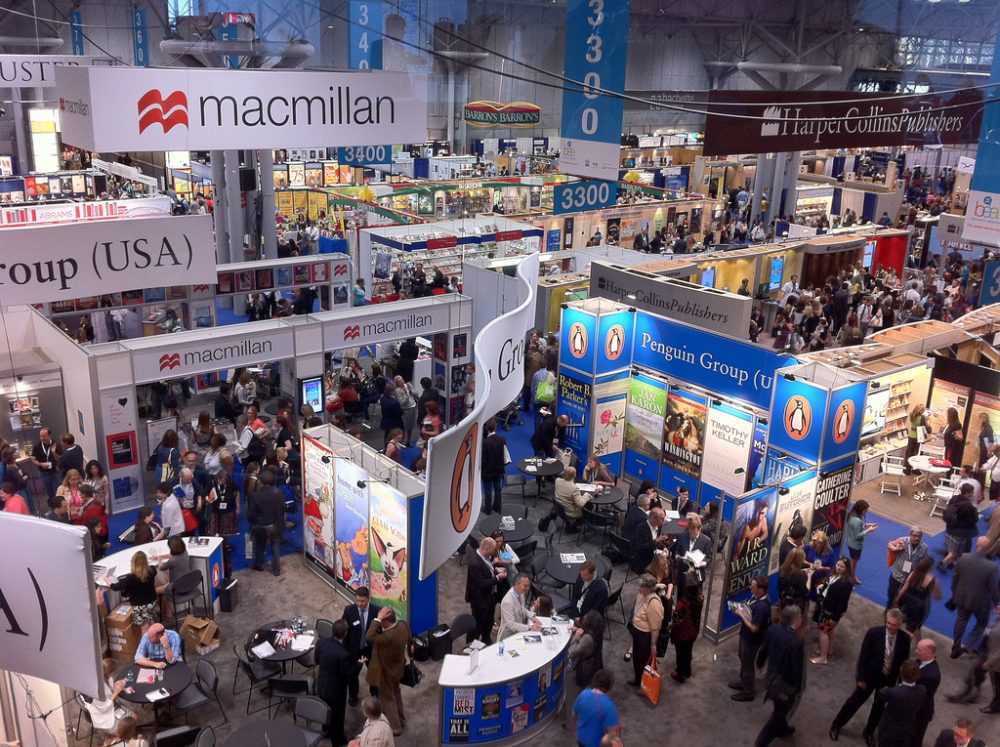
If you enjoy this post on the latest news and stories in the publishing industry, I recommend subscribing to The Hot Sheet, an email newsletter for professional authors that I write and edit with journalist Porter Anderson. On Sept. 15–17, we’re offering 30% off our annual rate for new subscribers in honor of our two-year anniversary. Use code 2YR when checking out.
Traditional Publishers in 2017: Holding Steady with Print Backlist and Audio
BookScan, which tracks US book sales, recently released a report showing that print sales are still increasing this year—up by 2.6 percent compared to the first half of 2016. More specifically, retail book sales (dominated by Amazon and chain bookstores) are up 4 percent, while mass merchandising book sales (such as Walmart and Target) are down 8 percent.
Ebook sales figures are not yet available for the first half of 2017, but early reports show a decline once again. Ebooks overall have lost about $1 billion of their value as a format for traditional publishers since 2013, when they peaked at $3.24 billion. In 2016, they declined to $2.26 billion, a 16.9 percent drop from 2015.
A few of the top print books for the first half of 2017 include the poetry book Milk and Honey by Rupi Kaur (notable because it was first self-published), Hillbilly Elegy by JD Vance, The Handmaid’s Tale by Margaret Atwood, and Camino Island by John Grisham.
Of particular note: Traditional publishers are experiencing strong backlist sales and soft frontlist sales as compared to last year. Frontlist sales are new titles, so publishers are experiencing some trouble getting new titles to break out (politics may be a distraction—see this AP trend article). BookScan’s list of top 10 print books for the year includes only one title published in 2017: Camino Island by John Grisham. Half of the list was published prior to 2015. (However, the folks at Publishers Marketplace noted on Twitter that this is not atypical. Last year it was two at this time; in 2015 it was three; in 2014 it was one.) Publishing industry vet and book marketer Pete McCarthy also noted on Twitter, “Marketing backlist is the ‘Moneyball’ equivalent of trading for a veteran you know can hit. Frontlist is drafting a high school pitcher.”
Audio continues to be the darling of the industry, jumping 18.8 percent in 2016 over 2015. And in the first quarter of this year, preliminary figures indicate almost a 30 percent increase over the same quarter last year; the Association of American Publishers says this is the third year in which audio has seen double-digit growth. But it’s still a low overall percentage of the market: in 2016, downloaded audio represented 1.2 percent of the market, according to the AAP.
Barnes & Noble Does Fine on Profits, But Not Sales in Fiscal 2017
Barnes & Noble’s outlook hasn’t been a rosy one over the last couple years, and their revolving door for CEOs hasn’t helped. (The latest CEO, Demos Parneros, took his position at the helm after a 30-year run at Staples.)
The good news is that B&N met their profit goals; the bad news is that full-year sales were down 6.5 percent from the prior year. Since B&N sales encompass many media, not just books, it’s helpful to look at earnings in the book category alone. Unfortunately, the decline is about the same—6 percent—partly due to lower sales of coloring books and juvenile titles. And they expect the sales decline to continue in 2018.
In Publishers Lunch (paywall), Michael Cader summarizes how B&N management, in an investor’s call, said they would address the challenges: launch a series of tests. Cader writes, “A lot of those tests focus on store layouts, ‘starting with space productivity,’ adjusting categories that are in decline and those that are growing.” That means: look for reduced space in areas of underperformance, including the Nook and music DVDs.
Always remember that B&N’s performance is not necessarily indicative of overall book retail health. As noted above, print book sales as tracked by BookScan show that the industry is not suffering the same rate of decline as B&N. Therefore, B&N is losing share to its competitors (Amazon).
In an article worth every author’s attention as B&N struggles, Nathan Bransford interviews Mike Shatzkin, who spells out the grave impact the loss of B&N could have on trade publishing, which was built on the ability of big publishing houses to put books on shelves. “That’s what they can do that authors can’t do for themselves and, up until now, Amazon couldn’t do for them either,” comments Shatzkin.
Starting with the premise that B&N sells two-thirds of the books sold through bookstores in the US, Shatzkin’s points include:
- Smaller publishers would be hurt worse by a B&N collapse, since they have fewer mass-merchant outlets (such as big-box stores, which trade mostly in bestsellers) for their books.
- Big publishers would find it less efficient but doable to launch trade books only through the disparate network of indie bookshops; smaller presses would have a harder time.
- Should Amazon Books (Amazon’s physical stores) keep ramping up quickly, then all publishing roads would, finally, lead to Seattle.
Amazon Probably Has About 70 Percent of the Ebook Market
Earlier this year, Michael Cader of Publishers Marketplace published a four-part series on the state of the publishing industry as told through various statistics. In that analysis, he offered the following market share analysis for ebook retailers:
- Amazon: 71 percent
- iBooks: 14 percent
- Nook: 9 percent
- Google: 2 percent
- Other: 4 percent
If you look only at the universe of Amazon ebook sales, Cader believes that self-published work constitutes about 40 percent of unit sales. However, he also estimates that publishers capture about 80 percent of the ebook dollars because of their higher pricing.
Cader also shows that self-published work accounts for about 60 percent of Kindle Unlimited reads and other borrows. The remainder is made up of titles from Amazon Publishing and the Kindle First promotional program (which offers Amazon Publishing titles only). Cader writes of Amazon’s proprietary e-reading programs, “[They] could be moving more units than all of the competitive stores together. It also means that Amazon Publishing … is on its own close to the size of the entire non-Amazon market.”
If you enjoyed this post on the latest news and stories in the publishing industry, I highly recommend subscribing to The Hot Sheet.

Jane Friedman has spent nearly 25 years working in the book publishing industry, with a focus on author education and trend reporting. She is the editor of The Hot Sheet, the essential publishing industry newsletter for authors, and was named Publishing Commentator of the Year by Digital Book World in 2023. Her latest book is The Business of Being a Writer (University of Chicago Press), which received a starred review from Library Journal. In addition to serving on grant panels for the National Endowment for the Arts and the Creative Work Fund, she works with organizations such as The Authors Guild to bring transparency to the business of publishing.

[…] Read the rest of this post HERE. […]
These statistics are so interesting to read, especially to see the impact Amazon has on traditional publishers and the massive percentage of ebook sales it’s responsible for. I wish I could see some statistics like this for my local Australian publishing marketplace (which is sooooooo small compared to the US) but I don’t even know where to start looking for such information.
Here are an article that may help:
https://www.booksandpublishing.com.au/articles/2016/09/30/74713/the-market-down-under/
I worry that Barnes & Noble is the only big house book store left. On the other hand my home town of Eugene, Oregon has two extremely popular book stores that do just fine. Amazon is a powerhouse and that worries me as well. That’s a lot of power and having a lot of power isn’t always a good thing. But the bottom is this: We will always have readers no matter what time we live in.
You wrote, “Ebooks overall have lost about $1 billion of their value as a format for traditional publishers since 2013, when they peaked at $3.24 billion.” Maybe the “agency pricing” battle of 2014 has something to do with it?
Oh, yes. That battle led to higher prices for ebooks, which has (seemingly) led to lower ebook sales overall for the Big Five, but more market share and sales for Amazon Publishing and indie authors.
And better value for the reader when we can avoid traditional publishers and buy at lower cost from indie writer-publishers instead. The Big 5 seem to enjoy kicking the reader but I guess their customers are book stores etc so they’re not that bothered about the reader anyway.
[…] your manuscript is ready for publication, Jane Friedman shares her publishing industry status report for 2017; and Melissa Bowersock gives the scoop on types of publishers, particularly service publishers, who […]
I’m so disappointed that the stats appear to be strictly trad publishing, making it a very incomplete report as well as of no use to the vast number of indie authors. The likely biased trad pub source cited said we’re 40 percent of the market. “At least” 40 percent is more likely. Either way, it’s a substantial chunk to ignore in assessing what’s going on in the market.
Hi Patricia – Perhaps it’s because I so extensively covered the indie market and stats in 2016, and for 2017, they haven’t shifted much. You can find those earlier discussions here:
https://janefriedman.com/looking-back-2016-important-publishing-developments-authors-know/
https://janefriedman.com/myth-print/
Interesting article, Jane. I’m an avid book reader who’s only recently purchased Scrivener as so will no doubt get something in ‘print’ at some point. As a reader, though, I’m not at all surprised that the ‘traditional’ publishers see a continuing decline in ebook sales. I awaited with bated breath the release of the latest in a series published by Harper Collins. On publication day, the hardback version went out for £39,99 [I’m a Brit], and the ebook version exactly the same price, with the softback published at the same time at £19,99.
This is insulting – £39,99 for an ebook?! Is HarperCollins in the business of shafting its readers? Yep! Unsurprisingly I (and several others) posted a scathing review, unfortunately possibly harming the author in the process but come on, Harper Collins. I assume they’re trying to get people to buy the hard cover version in preference to the ebook? But that’s silly because if I was going to buy the collectible hardback I’d just buy it.
As a shopper I rarely look at who the publisher is – I tend to go by word of mouth, reviews and price. I often buy both a softcover and ebook version. But I’m finding that I now ‘accidentally’ buy more self-published than traditionally published books simply because I get better value. I find errors in traditional published books and errors in self-published books, but I find very high quality self-published books for £2.99.
If I do manage to write a book myself I’ll obviously self-published, as I can give better value to my readers, earn better royalties, control the editing and cover design process……need I say more?
Wow, that pricing is … incredible.
Indeed. It’s the Collins New Naturalist series, which is for a UK audience and very much a ‘niche’ publication, so I can understand why the hardcover version is so expensive. The next hardcover and ebook in the series will be £60 on Amazon. They’re usually around 400 pages each.
It’s been so interesting to see print sales come creeping back. Nobody would have predicted that 5 years ago. Watching 2018…
[…] my Kindle Paperwhite, but it’s still not the same as picking up a physical book. Though even as print book sales rise higher and higher, society has this fear of books becoming extinct. Since I love to read, […]